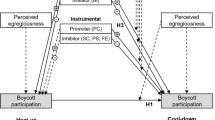Abstract
This paper reports findings of two field studies, conducted on a local online auction website, that compare bidding strategies in charity and non-charity auctions, focusing on the extent of jump bidding at different stages of auctions. Results indicate that jump bidding is negatively correlated with bidder entry and positively associated with ending prices. These correlations are greatest during the beginning stage of auctions and are substantially larger for charity auctions than for non-charity auctions. Additionally, early-stage jump bidding occurred more often in charity auctions (consistent with bidders trying to drive up prices in charity auctions), ending-stage jump bidding was more frequent in non-charity auctions (possibly used strategically to win the auction). Further, frivolous products tended to sell at a higher proportion of retail value in charity auctions, providing a replication of the results of previous researchers but in a field setting.
Similar content being viewed by others
Notes
A square root transformation provides an approximation for the Poisson distribution (Thacker and Bromiley 2009).
For study 2 we added a product-specific intercept to control for heterogeneity in the value across products.
References
Avery, C. (1998). Strategic jump bidding in English auctions. Review of Economic Studies, 65(2), 185–201.
Bulow, J., & Klemperer, P. (1996). Auctions versus negotiations. American Economic Review, 86(1), 180–194.
Carpenter, J., Holmes, J., & Matthews, P. (2008). Charity auctions: a field experimental investigation. The Economic Journal, 118, 92–113.
Cheema, A., Popkowski Leszczyc, P. T. L., Bagchi, R., Bagozzi, R., Cox, J. C., Dholakia, U., et al. (2005). Economics, psychology, and social dynamics of consumer bidding in auctions. Marketing Letters, 16(3–4), 401–413.
Daniel, K. D., & Hirshleifer, D. (1998). A theory of costly sequential bidding. Los Angeles: Mimeo, University of California.
Easley, R. F., & Tenorio, R. (2004). Jump bidding strategies in Internet auctions. Management Science, 50(10), 1407–1419.
Elfenbein, D. W., & McManus, B. (2010). A greater price for a greater good? Evidence that consumers pay more for charity-linked products. American Economic Journal: Economic Policy, 2(2), 28–60.
Haruvy, E. E., & Popkowski Leszczyc, P. T. L. (2010). The impact of online auction duration. Decision Analysis, 7(1), 99–106.
Haruvy, E. E., & Popkowski Leszczyc, P. T. L. (2009). Bidder motives in cause related auctions. International Journal of Research in Marketing, 26(4), 324–331.
Haruvy, E. E., Popkowski Leszczyc, P. T. L., Carare, O., Cox, J. C., Greenleaf, E. A., Jank, W., et al. (2008). Competition between auctions. Marketing Letters, 19(3–4), 431–448.
Isaac, M. R., Salmon, T. C., & Zillante, A. (2007). A theory of jump bidding in ascending auctions. Journal of Economic Behavior & Organization, 62(1), 144–164.
Isaac, M. R., & Schnier, K. (2005). Silent auctions in the field and in the laboratory. Economic Inquiry, 43(4), 715–733.
Jank, W., & Shmueli, G. (2007). Modeling concurrency of events in online auctions via spatio-temporal semiparametric models. Journal of the Royal Statistical Society—Series C, 56(1), 1–27.
Jap, S. D., & Haruvy, E. (2008). Interorganizational relationships and bidding behavior in industrial online reverse auctions. Journal of Marketing Research, 45(5), 550–561.
Popkowski Leszczyc, P. T. L., & Rothkopf, M. (2010). Charitable motives and bidding in charity auctions. Management Science, 56(3), 399–413.
Rothkopf, M. H., & Harstad, R. M. (1994). On the role of discrete did levels in oral auctions. European Journal of Operational Research, 74(3), 572–581.
Shmueli, G., Russo, R. P., & Jank, W. (2007). The BARISTA: a model for bid arrivals in online auctions. Annals of Applied Statistics, 1(2), 412–441.
Strahilevitz, M., & Myers, J. G. (1998). Donations to charity as purchase incentives: how well they work may depend on what you are trying to sell. Journal of Consumer Research, 24, 434–446.
Thacker, N.A. & Bromiley, P.A. (2009). The Effects of a Square Root Transformation on a Poisson Distribution Quantity. Tina Memo No. 2001-010, University of Manchester.
Author information
Authors and Affiliations
Corresponding author
Additional information
This research was supported by a grant from the Social Sciences and Humanities Research Council of Canada and the University of Alberta GRA Rice Faculty Fellowship. The authors thank Sandy Jap, Yu Ma, and Paul Messinger; Thomas Spalding; and seminar participants at the University of Alberta and the Marketing Science conference for helpful comments and suggestions.
Rights and permissions
About this article
Cite this article
He, Y., Popkowski Leszczyc, P.T.L. The impact of jump bidding in online auctions. Mark Lett 24, 387–397 (2013). https://doi.org/10.1007/s11002-013-9228-3
Published:
Issue Date:
DOI: https://doi.org/10.1007/s11002-013-9228-3




